After an overly eventful year, months of grey skies, and being bundled up against the cold weather, we decided to lift our spirits and head south to Spain. I didn’t feel like getting on an airplane, making travel arrangements, navigating public transit, etc., and made an executive decision we were going to San Sebastián, also known by its Basque name, Donostia.
I’d been twice before and knew the city a bit, but it has a lot going for it: It’s entirely walkable, I knew a great hotel, there was an almost-direct train from Paris, and the food is wonderful. Plus, it’s sunny, although the day we arrived was close to 1ºC (34ºF), but by mid-week, the temperatures rose to a comfy 21ºC (70ºF). Romain said to pack a swimsuit, just in case, but although a few hearty swimmers were braving the 13ºC (56ºF) water, we didn’t jump in.
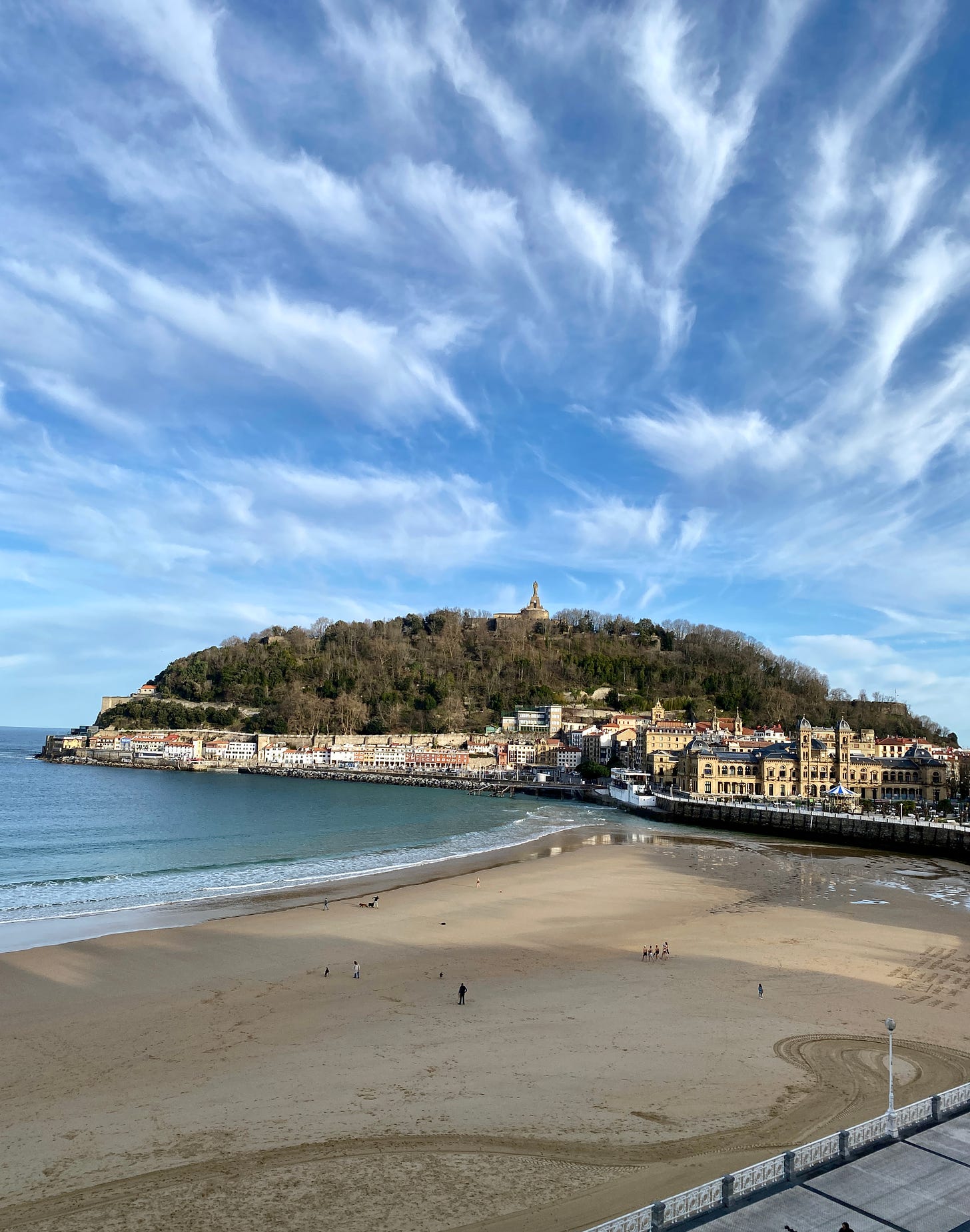
I love the hotel where we stayed, the Hotel Londres, which has rooms overlooking the bay. You can also book rooms that overlook the city on the other side of the building, but I recommend springing for a room with a view, which changes everything. It’s a grand-ish European hotel that isn’t overly chic (or expensive)—if you want that, you can stay at the Maria Cristina. But the Hotel Londres has a very friendly staff, the breakfast (shown above) from the buffet is excellent, the rooms are nice, and you’re close to the Old Town, where much of the pintxos action is.
I have stayed at the more budget-friendly Hotel Europa, which doesn’t offer any views but is economical and located a few blocks away, situated close to the old part of town, so you’re an eight-minute walk to the quarter, which is clustered with pintxos (tapas) bars. There are hotels in the old quarter, but I would not stay in one. Even off-season, it can be very loud at night with people spilling out onto the streets.
Spain is kinda great because there aren’t a lot of rules around food, and mealtimes are as-you-wish. People eat late; as you can see from our hotel (below), where they list the dining hours in the breakfast room in terms of affluence, and the later hours (according to them) are muy concurrido.
Despite guidebooks that tell you to avoid places with English menus, most pintxos bars have menus in Basque, Spanish, English, and French, and almost everyone was extremely nice, although you do need to be a little forward (not pushy or aggressive, but just let them know you are there) if you want to get served. If you’re just standing there, a few feet away from the bar, you may get overlooked. If you see a space at the bar, move into it as soon as it becomes available. If you hesitate, someone else will take it. They’re not being impolite, but “space” has a different meaning in Europe, and an open space will quickly be filled.
Don’t be discouraged even if a place is crowded; people often stop at a bar for a quick bite and a small glass of wine, beer, or cider (which the Basque region is known for) before moving on to the next place. And don’t be discouraged if they only pour you a glass that’s 25-20% full—the idea is to have a little bit to drink in each place.
The cider is fun to drink, which they pour from overhead to augment the bubbles, but Txacoli is a sharp and lightly sparkling wine that is fresh-tasting and is great to drink if you want something lighter and to drink local. A few places, such as Arenales, specialize in natural wines for those who want to give them a try.
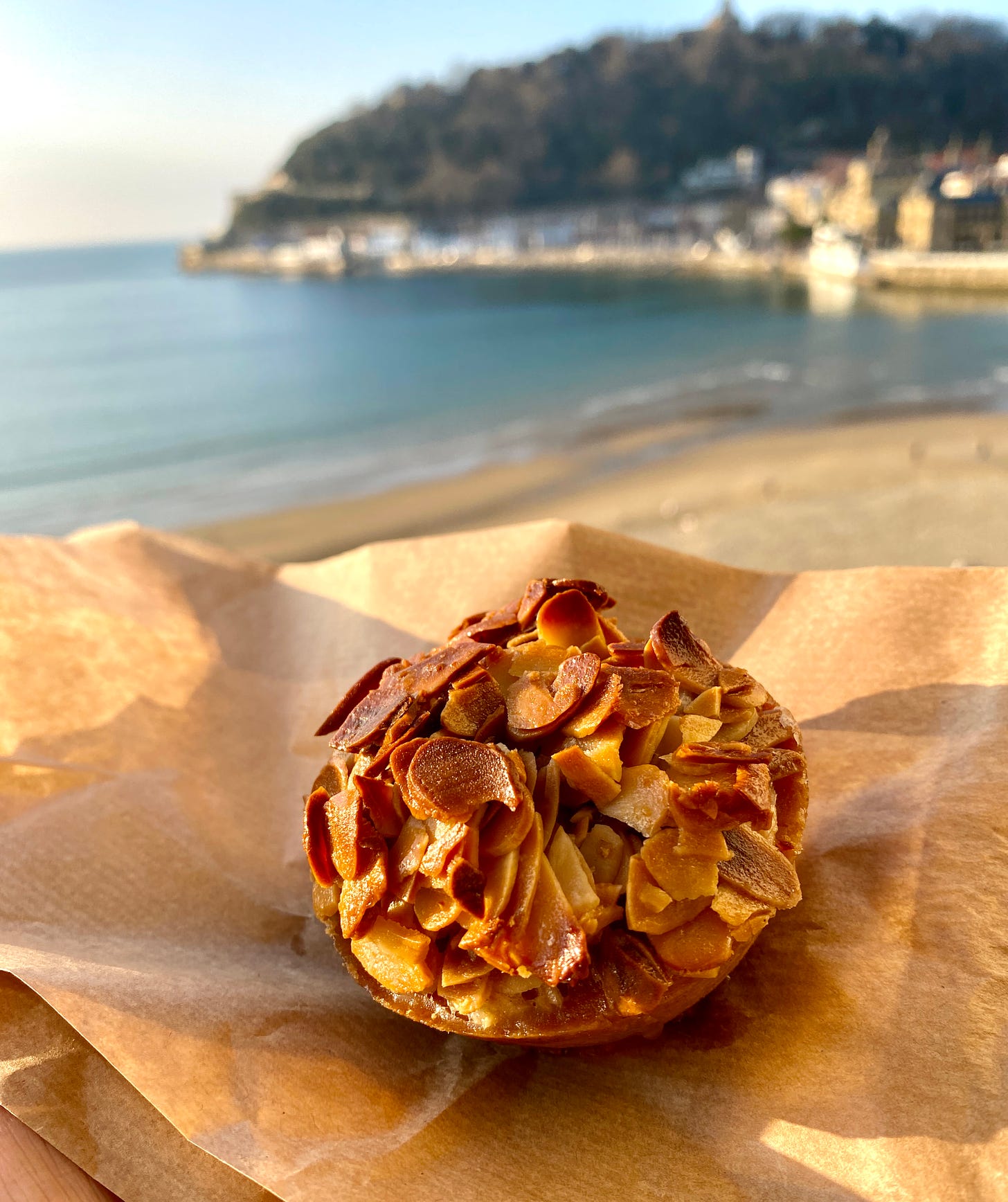
Before moving to France, I’d read how people lounged at thalassotherapy spas, a stay which was covered by the French health care system. When I asked my doctor in Paris to prescribe a stay for me, she laughed. But you can go on your own, and for $35 you can spend two hours in the thermal pool overlooking the bay at La Perla. (If you’re a guest at certain hotels, such as ours, you get 10% off certain treatments.) While Romain took off by bus to see the museum in Bilbao, which is an hour and a half away (locals said to take the bus over the train, which apparently is slower), my friend Kate of
recommended a trip to the spa. And who was I to refuse?I had a salt scrub, massage, and facial that wiped away a year (and a few wrinkles) of worry in just an hour. (¡Gracias Elena!) But I was primarily in town for the food. And here are some of the places we enjoyed.
Two quick tips: Most pintxos bars have quite a few things on display, mostly thick slices of bread topped with something. Those are fine, but inmho, you’re filling up on bread when there are other things to eat. So I recommend checking out the blackboard to see what they are cooking in the kitchen, or see what someone else is eating — that looks good — and ask for the same. Most pintxos start at around €2 each and go up from there. If you want a snack during the day, many cafés and bars offer pintxos and bocadillos, small sandwiches, and it’s not unusual to see people engaging in an almuerzo, a late-morning/mid-day snack.
People in Spain tend to eat later than in other places. Lunch is between 2 and 4pm. Most pintxos bars don’t rev up until 8pm and stay busy until at least 10pm. When dining in a restaurant for dinner, if you go before 9pm, you may be the only customers, as dinnertime can begin at 10pm.
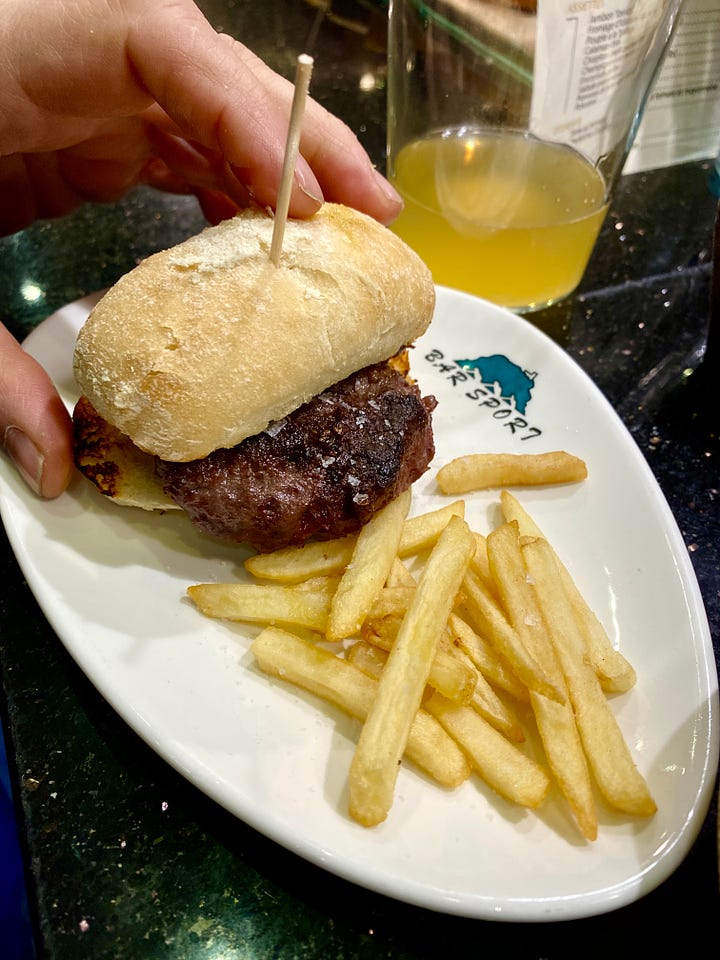
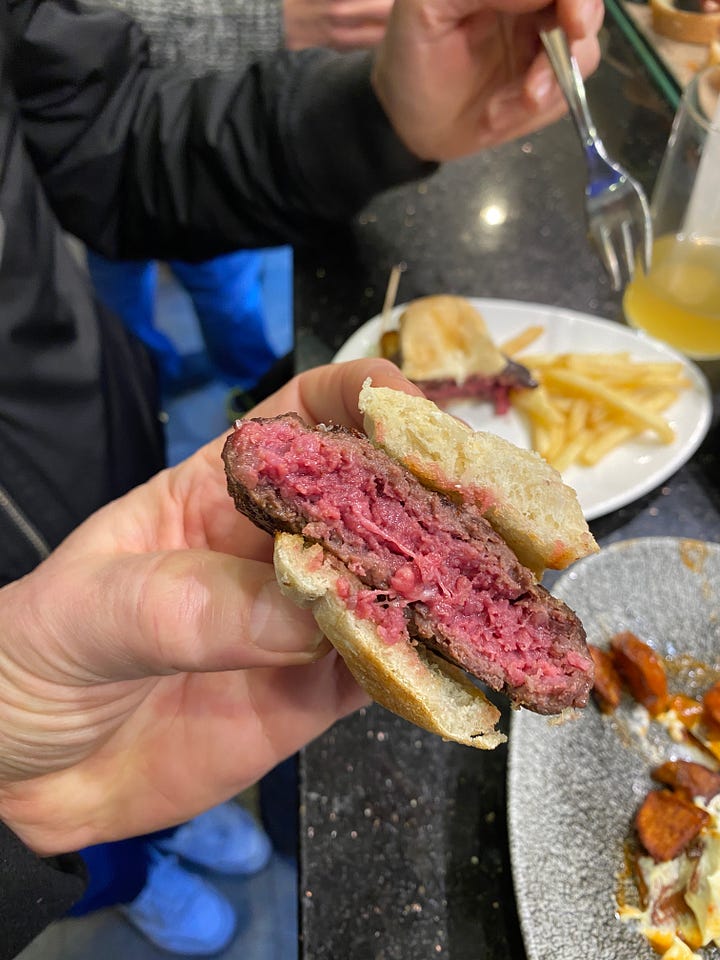
Bar Sport is a local favorite and always crowded, and one of the most fun pintxos bars in town, with a friendly staff and crowd. We didn’t have the famous sea urchin cream or the foie gras this time but instead had a mini hamburguesa txuleta, which the Basque couple next to us had also ordered, along with a plate of patatas bravas (fried potatoes with mayonnaise and hot sauce) and a few glasses of sidra (cider) before moving on.
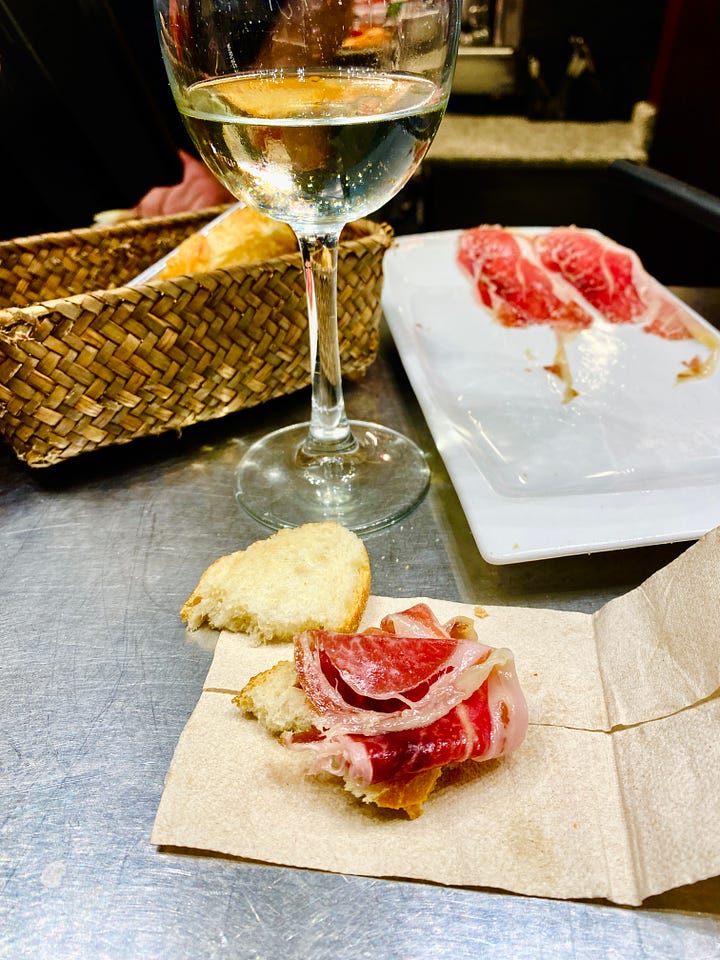
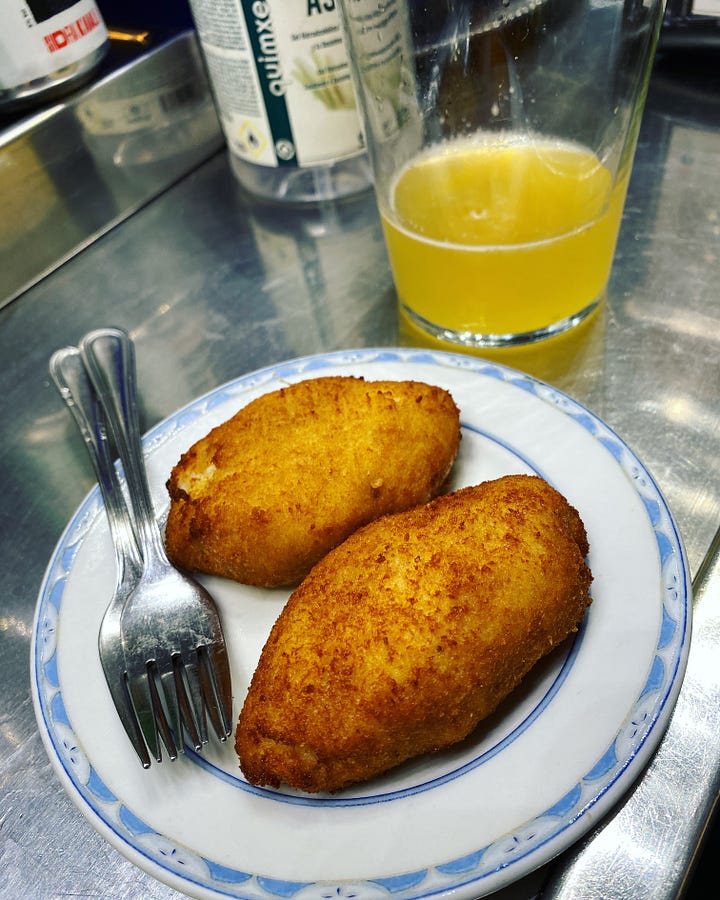
Bar Martinez has a very nice selection of warm pintxos, and we had a plate of ham croquetas, which I can’t resist. The tortilla patata (potato tortilla) was very good, and we also had some deep-fried shrimp, whose batter masked the taste of the shrimp a little too much for me. But the platter of jamón Ibérico (Iberian ham, which you should also eat when you’re in Spain) was excellent with glasses of txakoli wine.
We actually ate here twice; the second time was after a somewhat unpleasant experience at a pintxos bar down the street, where we were roundly ignored while everyone else got served. I finally deduced it was likely because we were a male couple, and we left. Romain was fuming and said, “They are lucky I don’t speak Spanish!,” and we headed back to Bar Martinez, where we were warmly greeted and made up for the attitude of the other place. After we left Bar Martinez, Romain said, “That erased the bad experience at the other place.”
While not pintxos, I like to stop in local bakeries when I travel. We took a mid-afternoon break for a pastry at Geltoki. Spanish pastries can be a bit sweet to my taste, so I look for the simplest things when I go to a bakery and try to focus on pastries that reflect the local flavors, such as queso (cheese), almonds, and fruit that’s in season. The apple tart (above) was a stack of cooked apples with caramel sandwiched together into one almost-neat slice. It was perfect with a few café cortados (small coffee with milk). The tarta Ondarreta in the window looked good, a rectangular tart made with toasted almonds, which I’m going to try next time.
Also not pintxos, I decided on a special treat: We’d go to Arzak for lunch. This region has a very high concentration of Michelin-starred restaurants, and while I don’t eat at fancy Michelin-starred places much—it’s not my thing, Arzak is a special place. Led by Elena Arzak, you’ll be warmly welcomed. No ties and jackets are required (they want diners to be comfortable), and after we ordered the tasting menu (€250), they said that we could do whatever we want — if we changed our mind about a course, even if it had already been ordered, we should feel free to change it.
It’s quite different from the stiff service you’ll get in other restaurants of this caliber, and many of the other guests were neighbors and regulars. I remembered the waitress from 15 years ago, and she said she’s been working there for 26 years. The prices have gone up since then (I think last time it was €99), but while it’s not cheap, it’s not as expensive as three-star restaurants elsewhere.
Arzak is located in San Sebastián, and we took the bus there and walked back to the hotel. Next time I want to try Extebarri, where the food is cooked over an open fire, but it’s an hour away by car. So that’s another trip.
La Cuchara de San Telmo is one of the most memorable places I’ve eaten in my life. I don’t know if it was so well-known when I went there 15 years (or so) ago, but it’s not a secret anymore. Still, it’s very friendly and fun despite its popularity. And the food is some of the best I’ve had in the world. Yes, you’ve read that right.
The first thing on the menu, the suckling pig cooked slowly in beer, served with a crazy-good crackling crust, is sooooo good. While people also like the crisp pig ears, the roasted goat cheese with grilled chiles and chile emulsion was also sensational.
(In related news, someone left an unflattering comment about the look of the sauce on one of the plates of food here on Instagram. People in restaurants work very, very hard, and they do the best work they can. The food here is particularly excellent, and there’s no reason to leave a comment anywhere that you don’t like the look of something. It’s very disheartening for me to read comments like that, and I hope the people who make the food don’t read them, so now I delete the comment and block the person from commenting. So don’t be one of those people…and please be nice!😊)
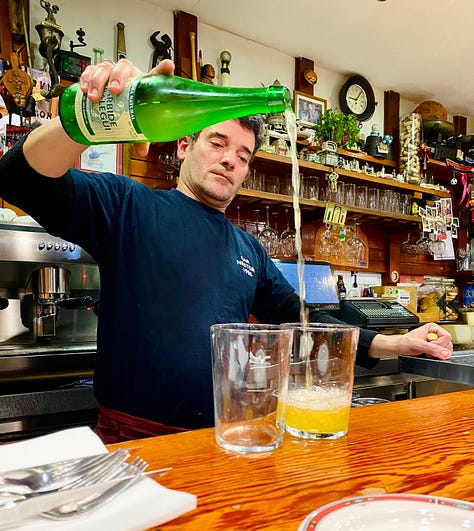
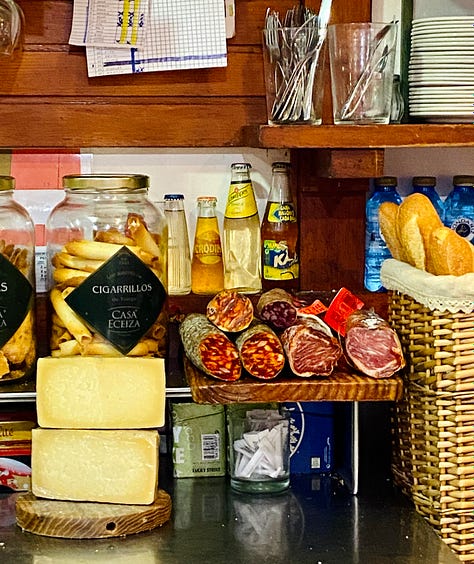

When my friend Peter saw that I was in San Sebastián/Donostia, he said he had the best non-aged steak of his life there, which he added may have been the best steak of his life, at Bar Nestor. I didn’t look too closely at the menu online, but it’s a place to go if you’re hungry. Very hungry.
They start out by bringing you a plate with a few steaks on it, and you pick which one you want. (Below.) They also ask if you want a plate of tomatoes and/or fried padrón peppers (€6 each), or perhaps some charcuterie, which we declined after I saw the steaks. The steak comes out a few minutes later on a sizzling metal plate, showered with flaky salt. It’s served very rare, but you can sear the pieces of meat on the plate using a fork, to take the raw edge off them. I find steak that’s too rare hard to chew and enjoy, although my Frenchman usually likes his beef bleu, or very rare.
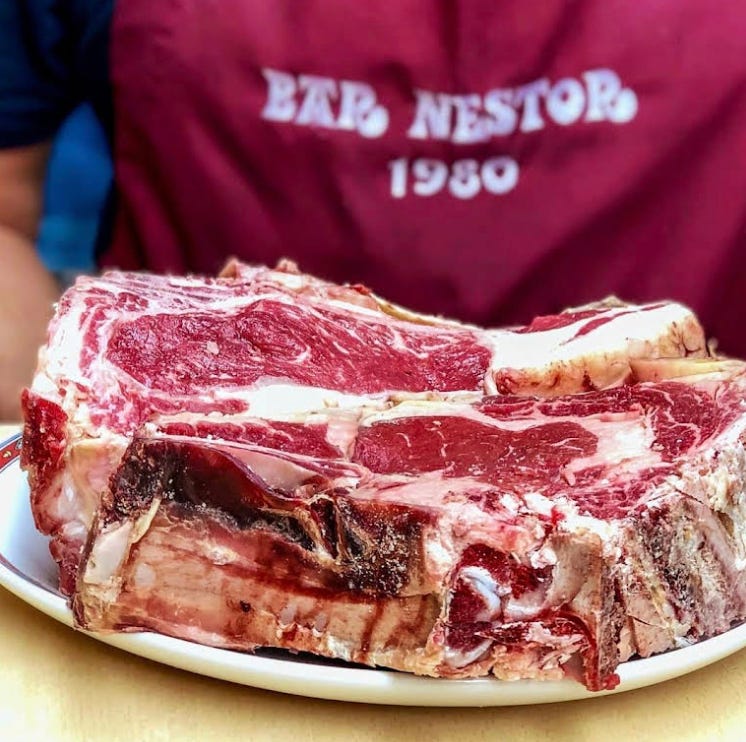
The meal was €66, and you mostly eat standing at the bar, although there are some tables. One was occupied by a group that was pretty loud (Note to people: There is no need to scream in restaurants, unless you’re Romain and you’re not being served), and the place is small, so we moved when another place opened up at the bar, and it was a lot more convivial, and enjoyable.
After our beefy evening, while Romain took the bus to Bilbao to visit the museum, I went for a walk after my D.O.B. (day of beauty, which was actually a demi-D.O.B.) at the spa and passed by a sushi place. While I hear the argument, “I didn’t come to France to eat Japanese (or Mexican, or Vietnamese, or Lebanese) food,” it was what I was craving.
Another sign was when I was using Google maps to find the bakery that had a good Gâteau Basque, Kai Sushi popped up nearby. It’s hard to find good sushi in France, and I wasn’t expecting much, but it turned out to be very good. I’ve had great Lebanese food in Mexico and fantastic French pastries in Japan, so why not good sushi in Spain? Another bonus: It wasn’t overly filling, and since it was our last full day in San Sebastián/Donostia, we had a big line-up of places I wanted to go to before we left, and was saving some space.
So I did find the good Gâteau Basque at Pariès but was surprised to find a gorgeous line-up of chocolates and candied almonds. Like a magnet, my body moved over to the showcase where the owner took care of me, filling boxes and explaining what was going in each. My Spanish is rusty, and my Basque is non-existent, but the proof is in the pudding or, rather, the flavor, and everything I tried, I loved, including the Espalines, candied Spanish almonds with piment d’Espelette (which are also available enrobed in dark chocolate — I got both) and crispy hazelnut praline bâtons coated with dark chocolate known as Goxo Noir.
Local Basque cuisine expert Marti Buckley wrote that, yes, Pariès makes their own chocolate, which I think the owner was telling me. Chocolate came to Spain and traveled through the Basque region and into France, so the region has a legendary history of chocolate-making. (A good read on the subject is Crafting the History and Culture of French Chocolate.) In the end, the weight of my suitcase doubled after my visit here, and I’m not complaining, but I was delighted to learn when I got back to the hotel and saw the other addresses listed on the side of the bag that they have a shop in Paris, too, when it’s time for a refill.
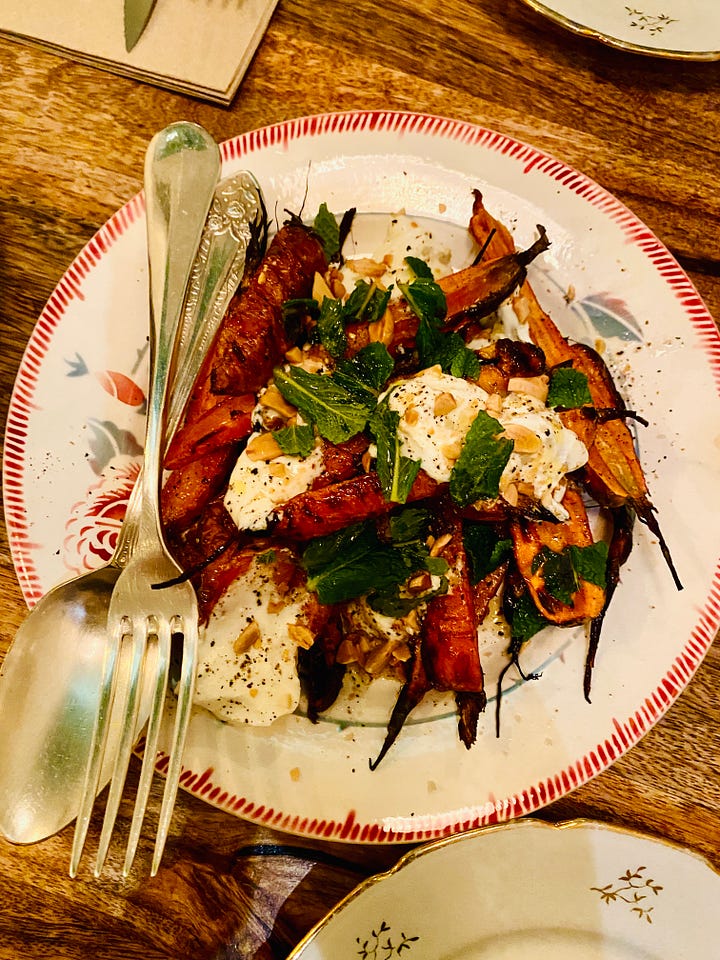

For our last night, we stopped at Arenales, which is very small, and very (very) delicious. The plate of roasted carrots we had (above, left) with thick gazta cream and anchovy vinaigrette were literally some of the best carrots I’ve ever tasted. And that’s coming from someone who worked at Chez Panisse for 13 years, where the angels delivered the produce picked that morning, direct the farm. Boy, were those good!
And the raviolis filled with ricotta and served with mussels were equally excellent. We got there at 8pm, and the place was half full, but I imagine later in the evening the place is packed and with good reason.
Finally, we ended with Basque cheese at La Viña, which is famous for its Tarta de Queso, now known as Basque Burnt Cheesecake. The cheesecake isn’t actually burnt. Burned food is black and tastes burned, and you can’t hide that flavor. Browned is well-cooked, with a deeply caramelized flavor.
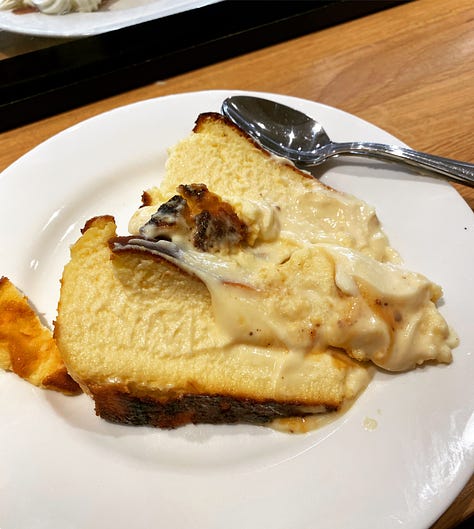

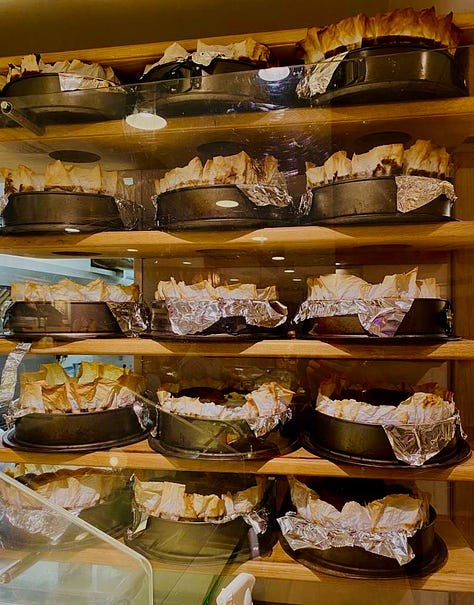
As you can see, it’s not really burnt. But it doesn’t need any marketing or additional hype; it’s truly delicious and worth the adulation. They sell it by the slice or, rather, by two slices, and you can even get them to go. I imagine there’s a line during high season, but I was happy to visit in March when we could just walk right in and order one. Or two, I should say.
We just had two and a half days, and we fit in what we could. Also on my radar were Geralds Bar, Mendaur Berria, Ganbara, Txepetxa, and Borda Berri. If you go, it’s nice to have a list of places to go but also great just to wander and see what looks good. If a place looks fun, go for it!
Some Travel Tips
We traveled by train from Paris, and presently there are two direct trains to San Sebastián/Donostia. You can find train tickets on the SNCF website as well as on Trainline.
If traveling by train in France, check the website early when planning your trip as first-class seats can often be had for just a few euros more than second-class seats if purchased far enough in advance. French second-class trains are fine, but for longer trips like this one, the upgrade makes the journey nicer. Traveling in the summer is going to be a lot more hectic than travel in the off-season, and the weather in the Basque region is generally mild in the fall and spring.
(If you are over 60, you can get a Carte Avantage Senior for €49, which gives a generous 30% discount on train travel and caps travel fares in second class, so it may be worthwhile, especially if taking multiple trips. Other adults can get a Carte Avantage for other discounts. Once you buy the card, you get a discount code by email and/or via the app, which you apply when checking fares.)
Our train to San Sebastián left at 7:08am, and the bar/café car was closed for most of the trip. The food in the train stations in Paris has dramatically improved with culinary stars operating kiosks, such as Eric Kayer, Gontran Cherrier, and Pierre Hermé, where you can grab a sandwich, pastry, and coffee, and many are open very early. The food on the train has also improved quite a bit, but it wasn’t the first time I’ve been on a train where the café car was closed for “technical reasons.” So I always bring along something to eat for long train trips.
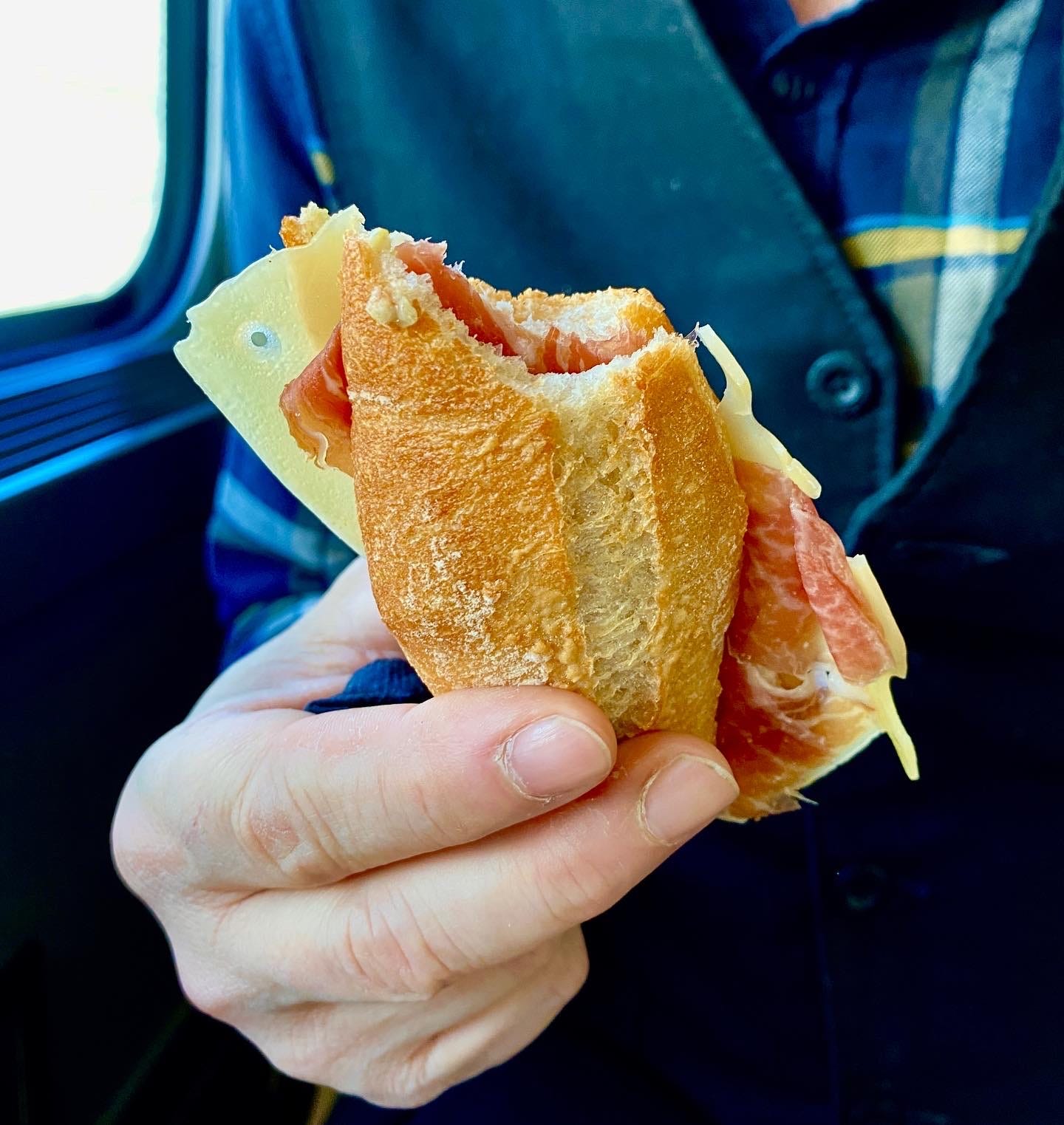
When taking the train to San Sebastián/Donostia, if you’ve bought your tickets from the SNCF (the French train system), the train goes to Hendaye, at the Spanish border, where you’ll need to change trains due to the difference in the size of the train tracks.
We weren’t able to download or print the tickets for the Hendaye-San Sebastián/Donostia leg of the trip since, or get the QR codes on our phone on the SNCF app because, according to the SNCF, it’s in Spain. Instead, you’ll get a reference code with a note that it’s to withdraw your ticket from a self-serve kiosk before setting off on your trip, which you should be able to do in France.
(If traveling in France, the SNCF app is quite good, and you can store your tickets on there, although internet service is very spotty along the route in France — and I’ve never had good luck staying connected to the onboard WiFi — so you may want to screenshot the QR code for your tickets so that they’re handy when the conductor on the train comes by to check them.)
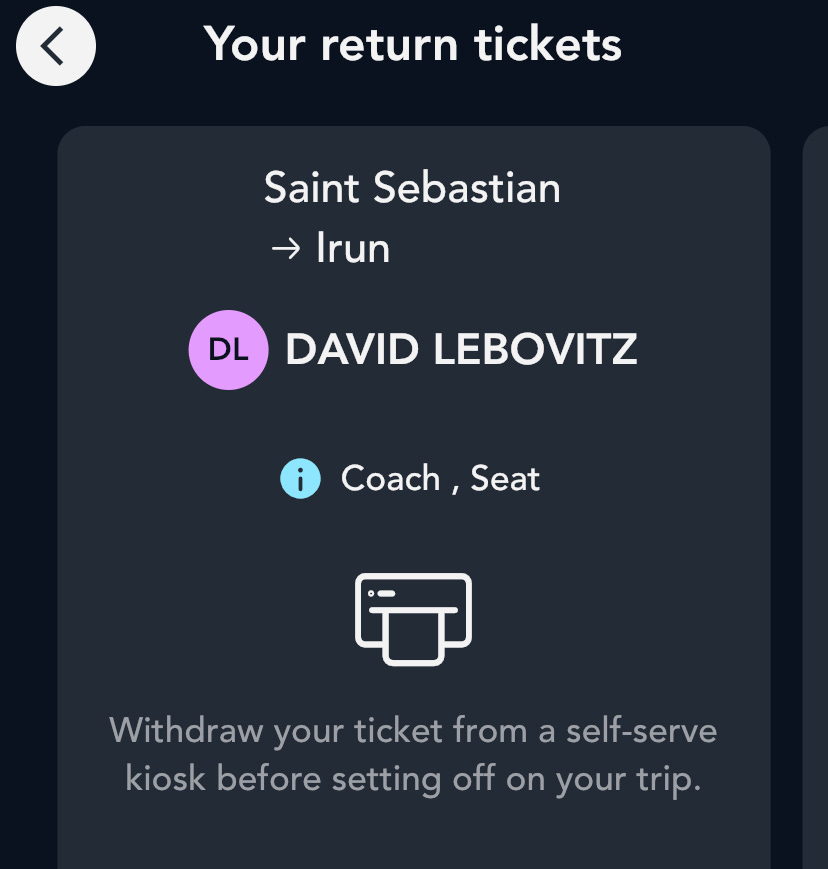
We got a little confused with the tickets from Hendaye (or Irun) to San Sebastián/Donostia and ended up buying tickets since I tried to get the tickets at the Spanish train system kiosk, which seemed logical, but since the two tickets were only around €2,50 each, I just bought tickets. But do download your tickets at an SNCF kiosk in France, using the reference code they give you when you’re buying your tickets.
You’ll be on a local train in Spain, and there are a few stops. The station in San Sebastián/Donostia that’s closest to the center of town is Amara, which is an 8-10 minute walk to many of the hotels.
On the way back to France, take the train from the Amara station to Hendaye, not Irun. When in doubt, ask an employee or someone at the ticket counter for assistance.
We did enjoy our stay at the Hotel Londres very much, and I would stay there again. When booking, a seaside view is preferable, and don’t forget to add the breakfast option.
This post is for all subscribers. Thanks for subscribing!




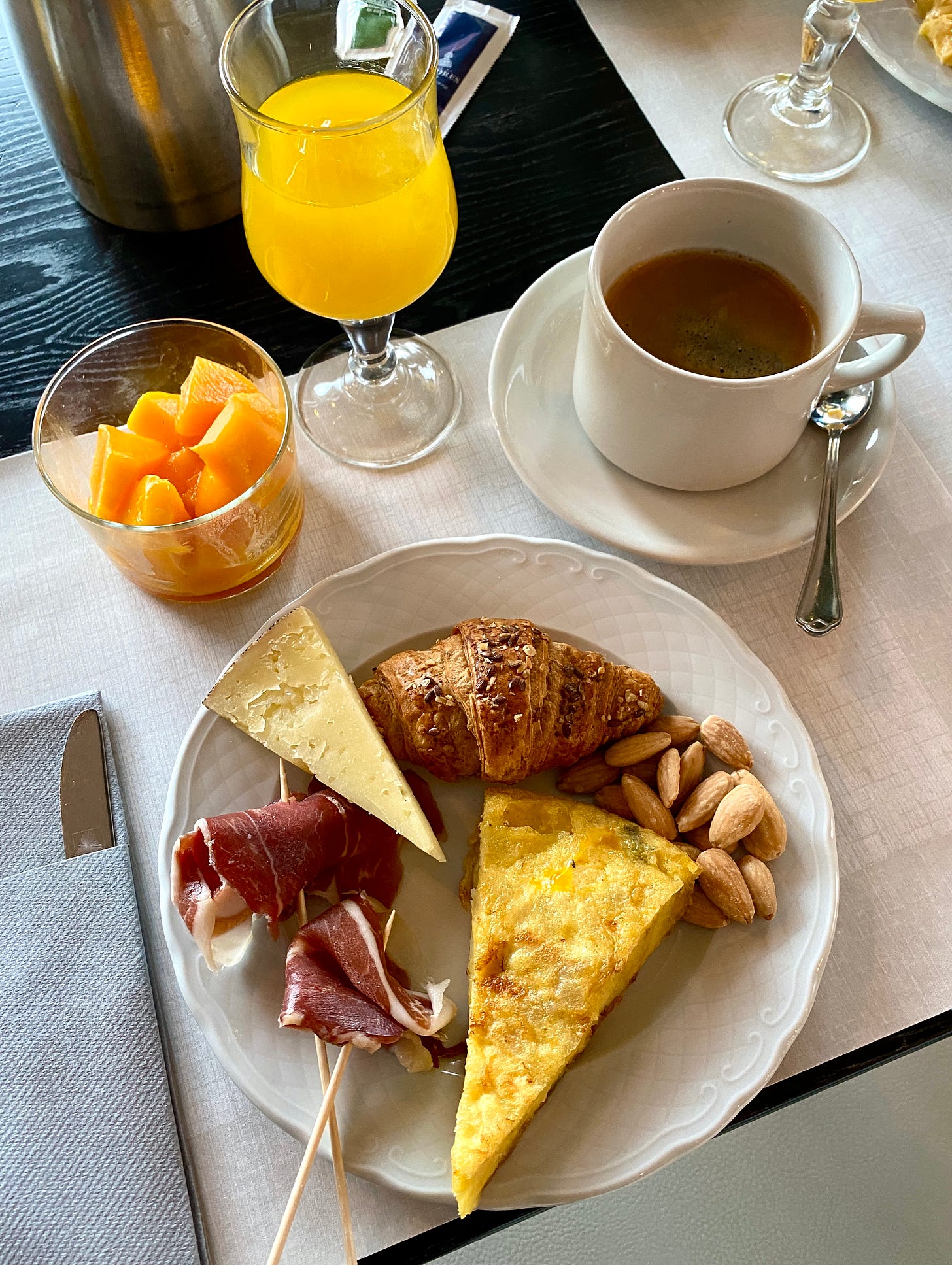
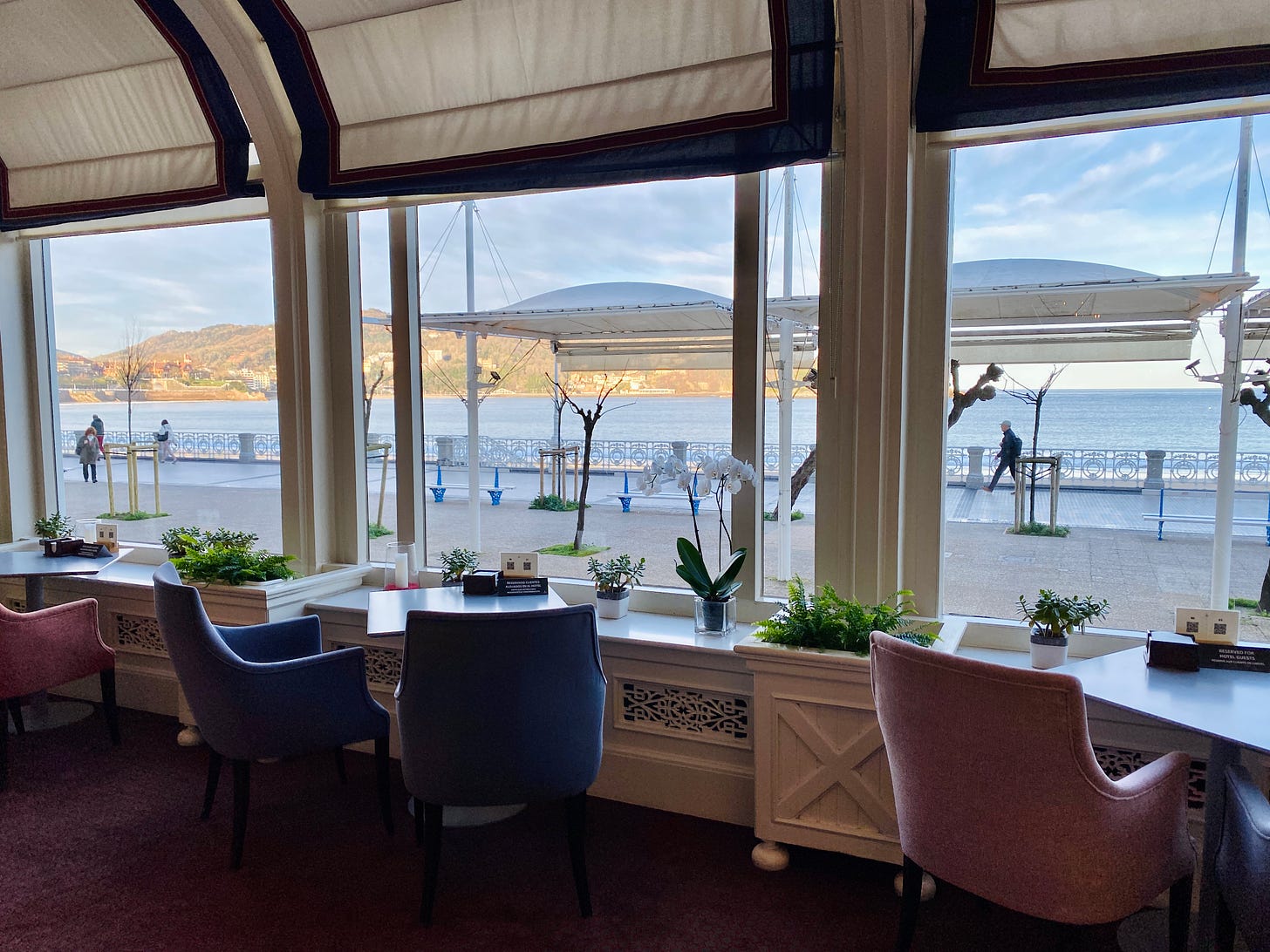
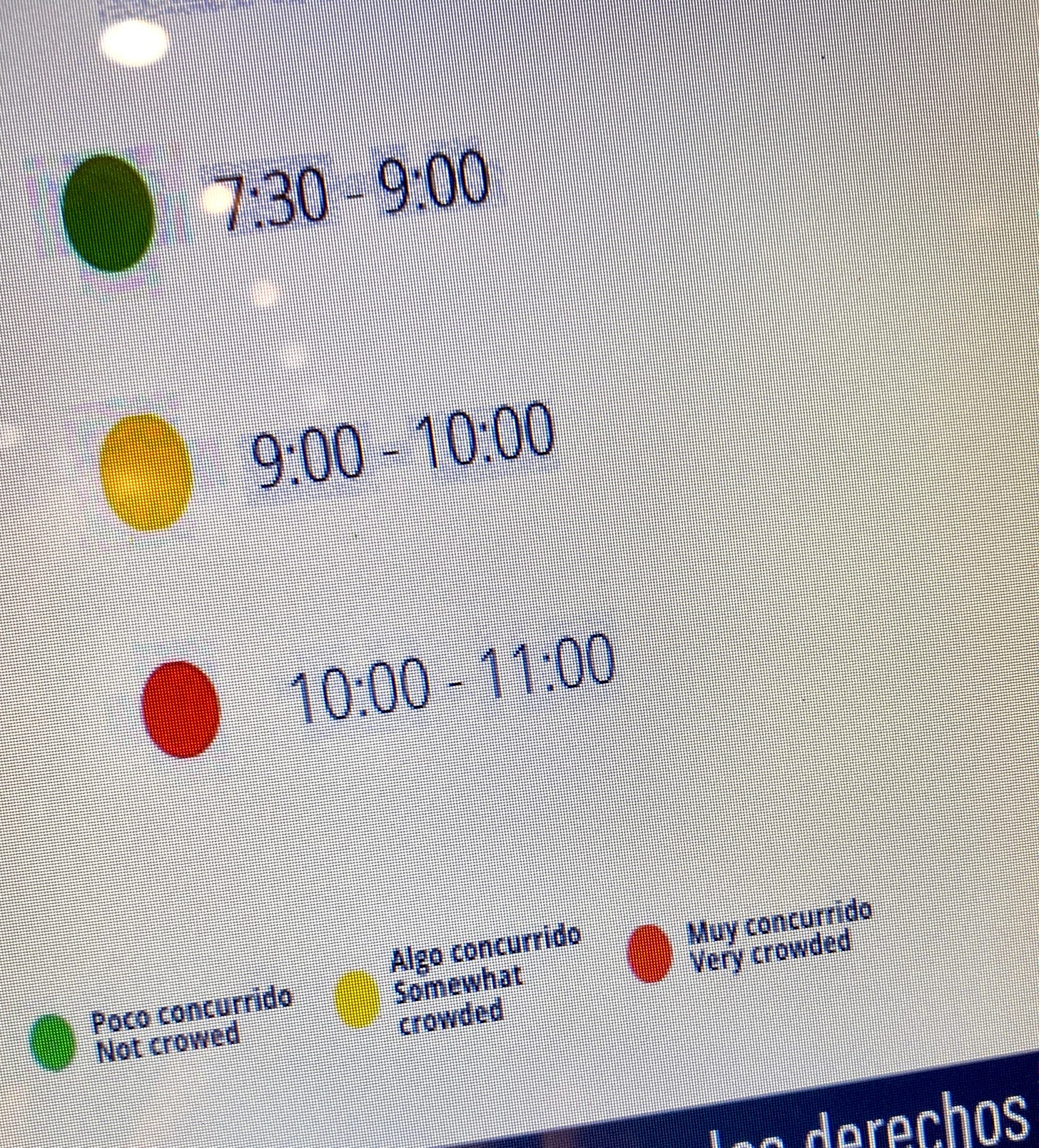

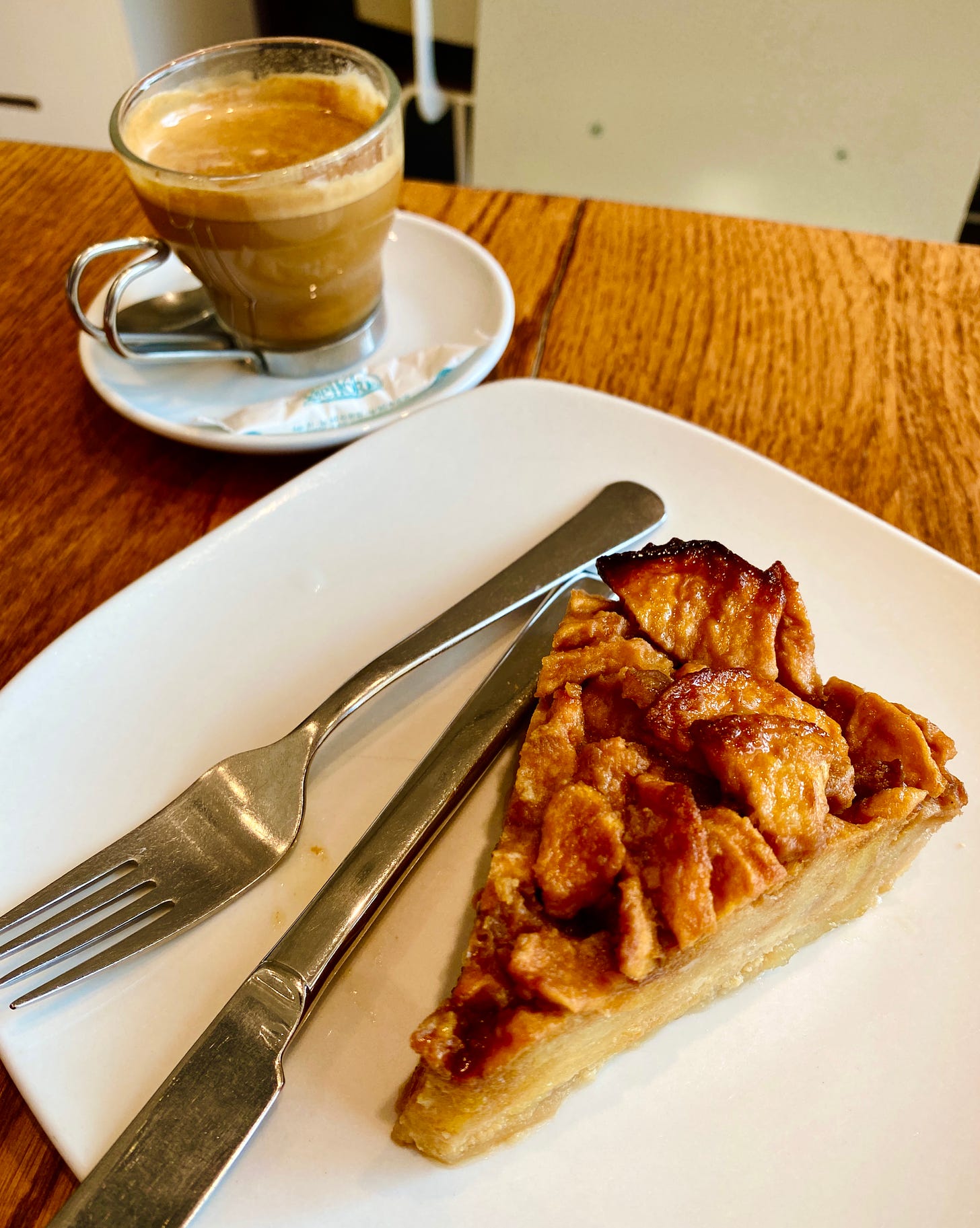
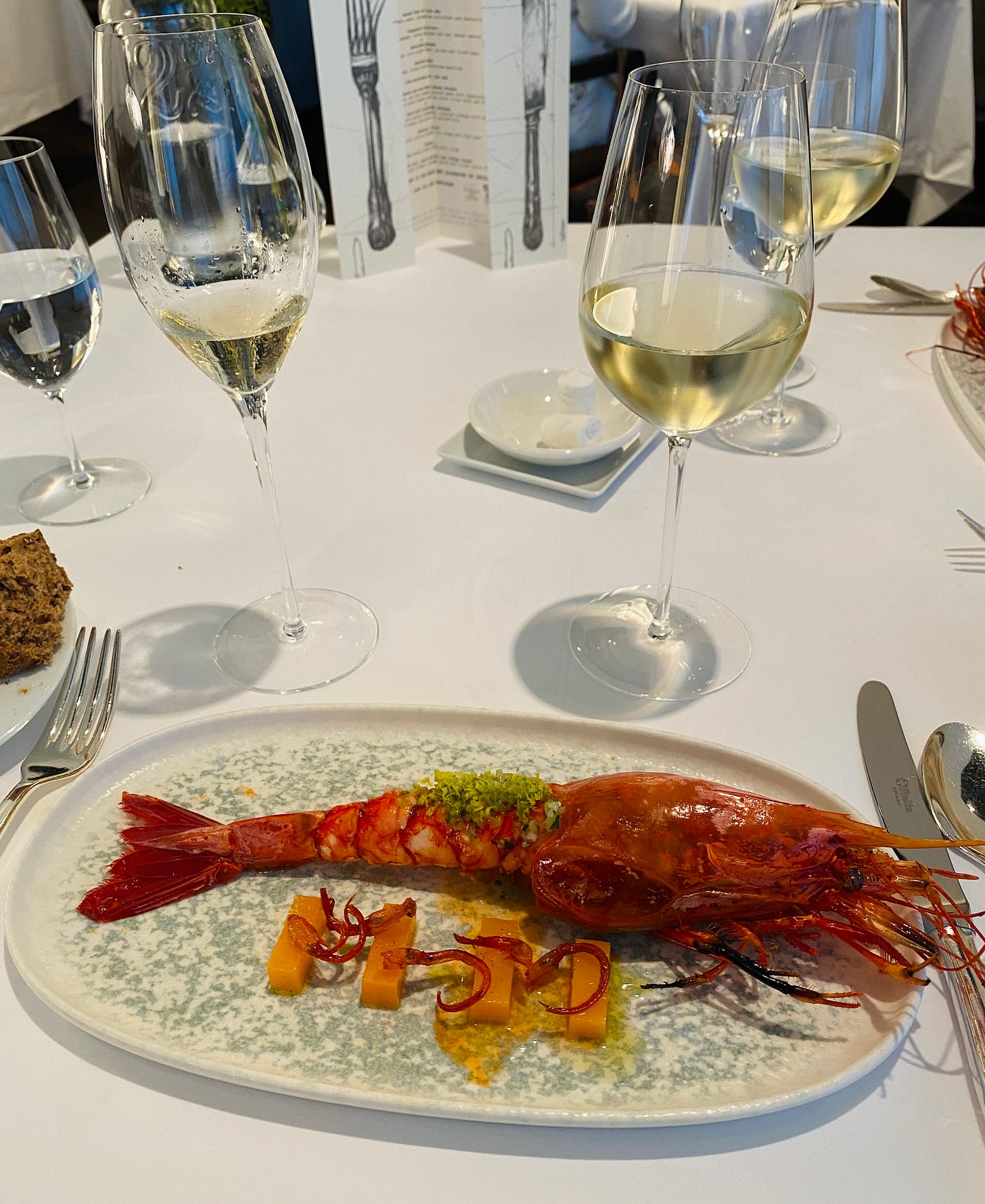
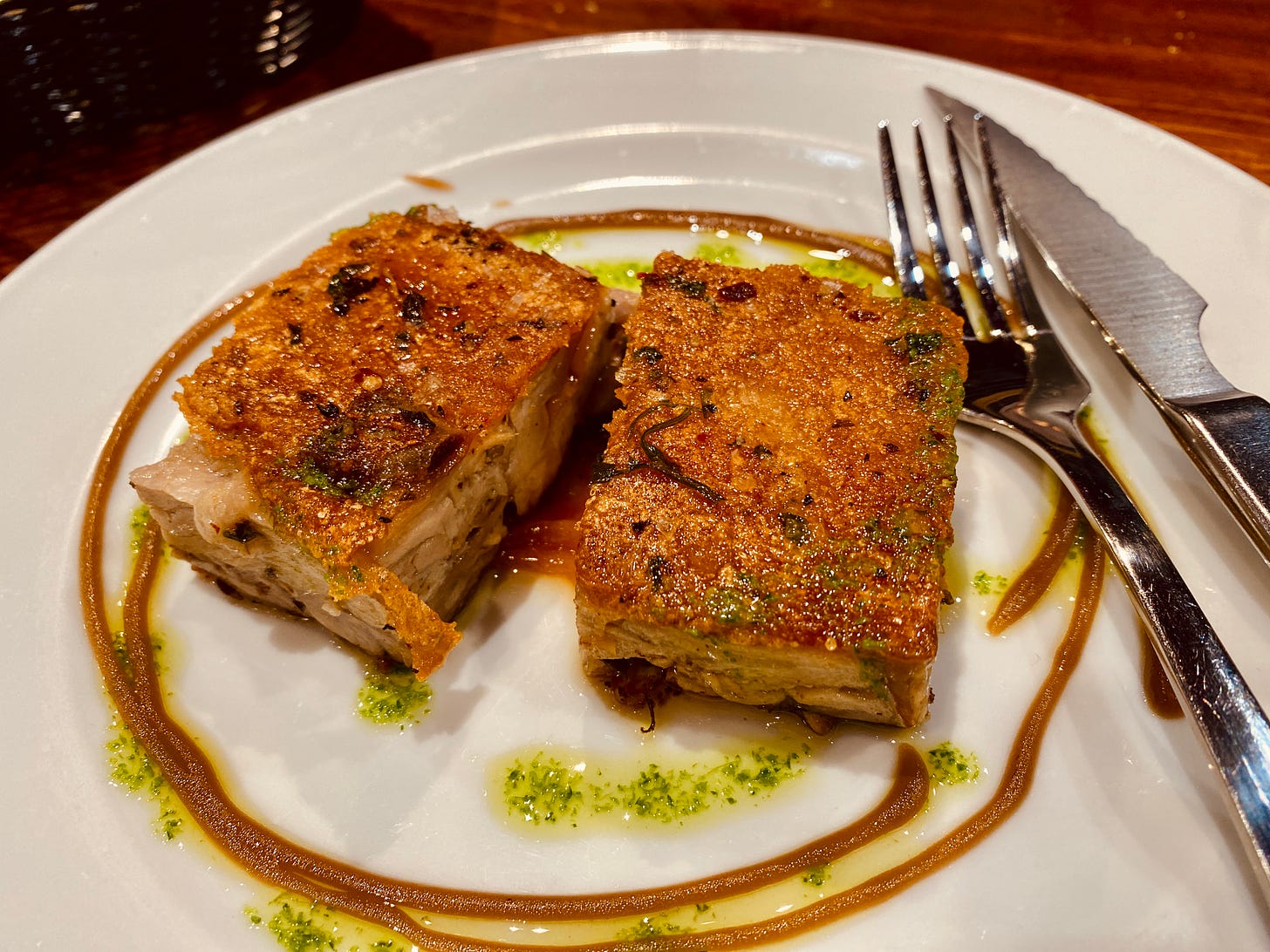
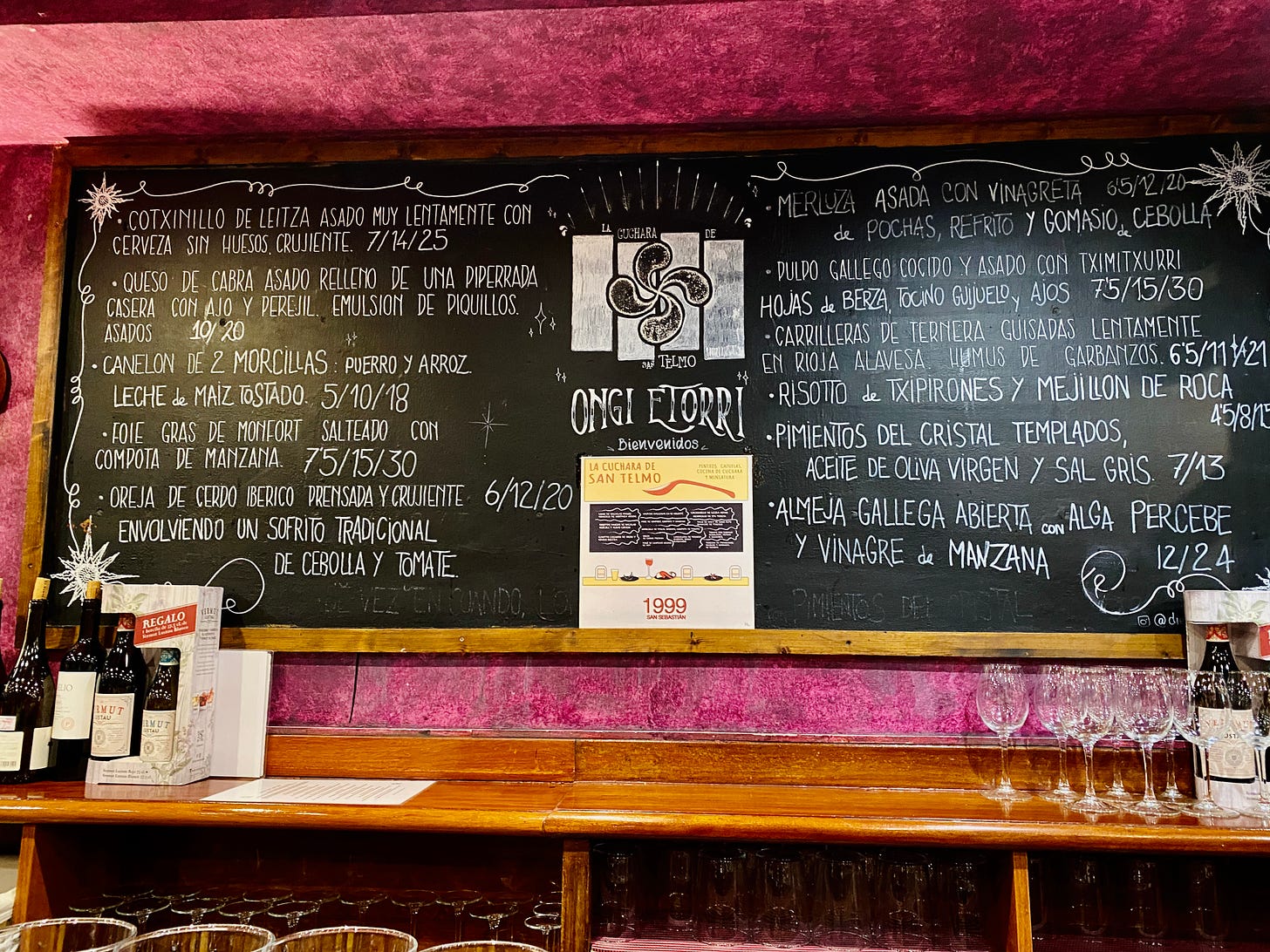

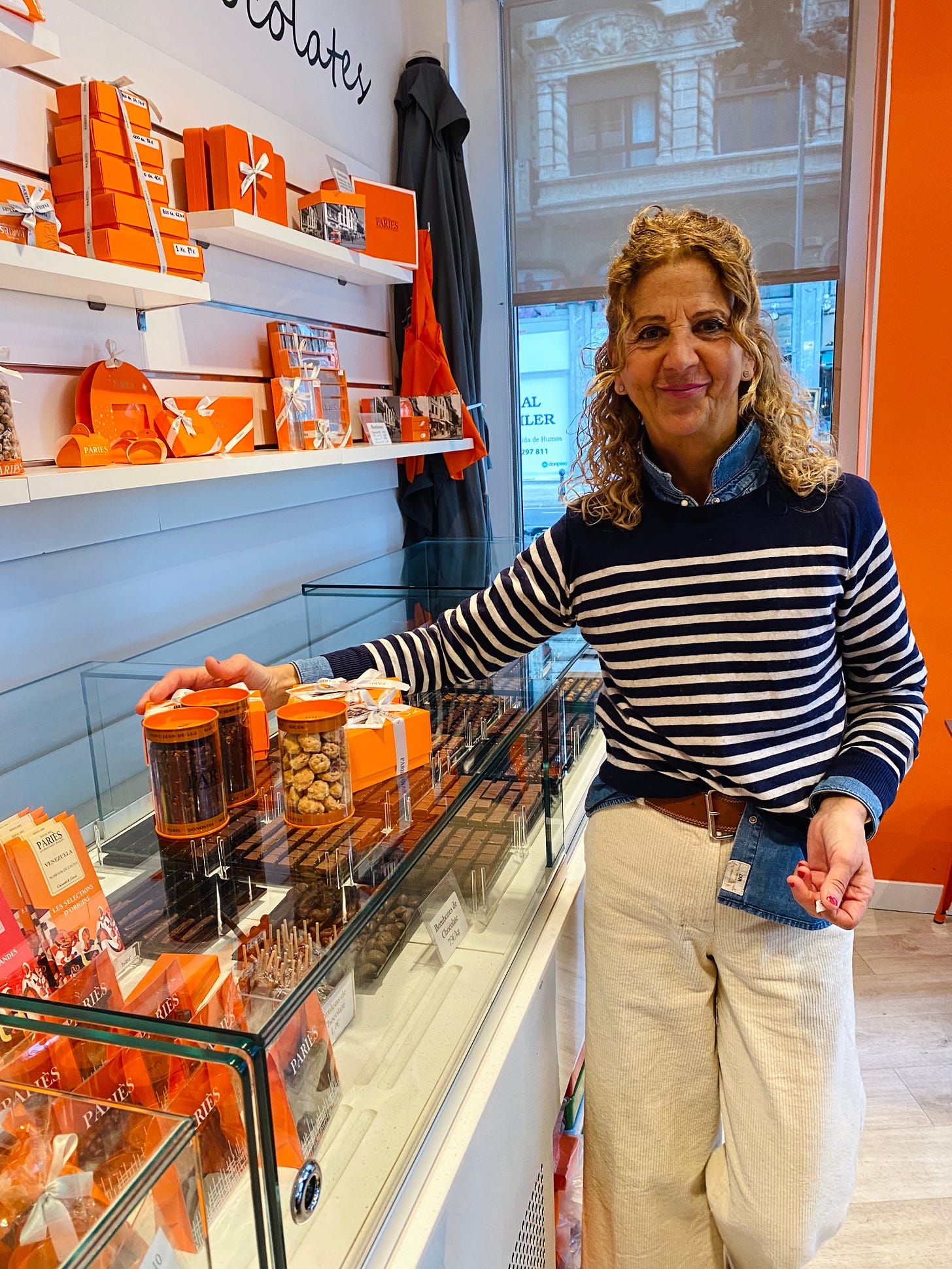
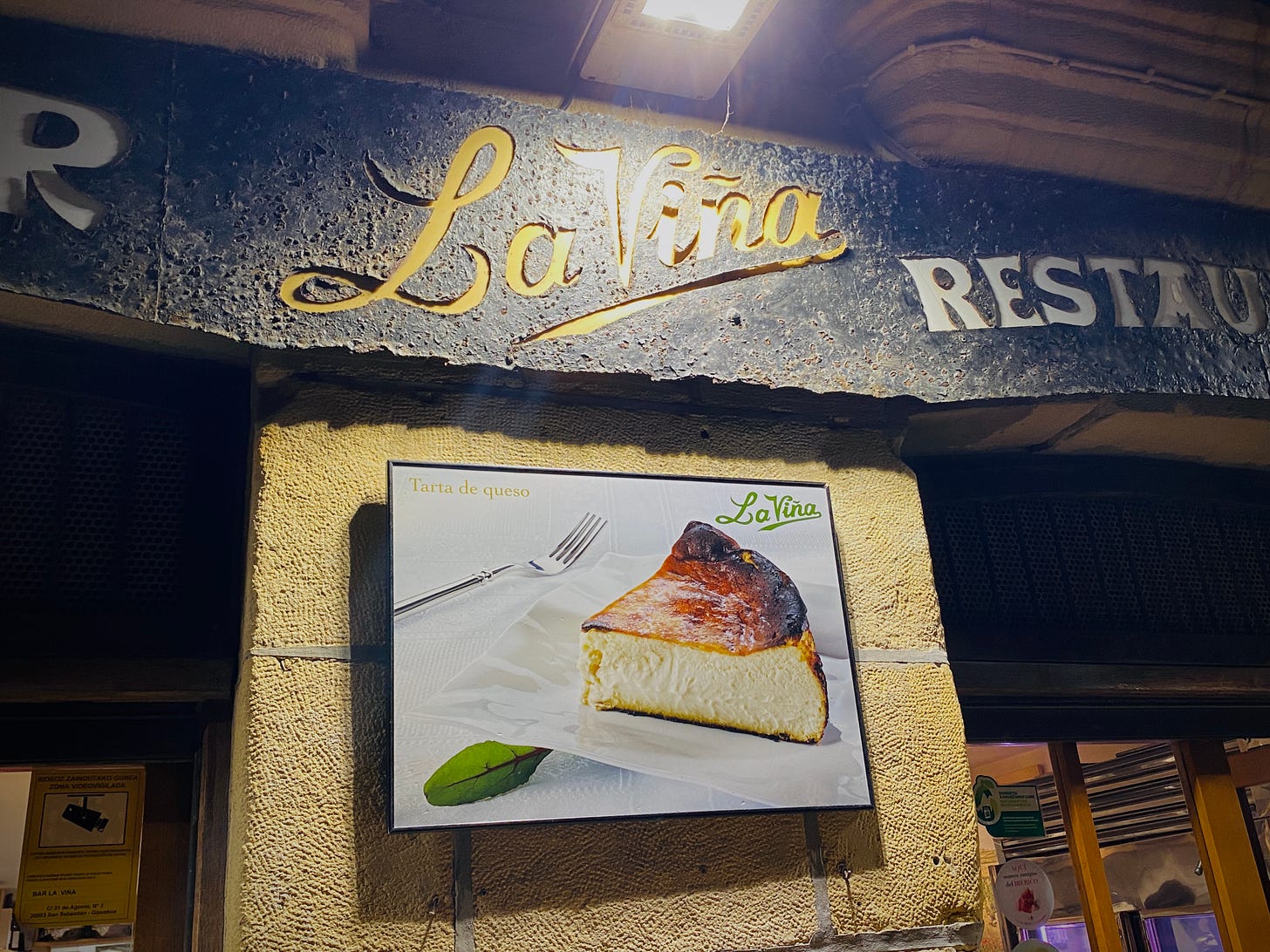

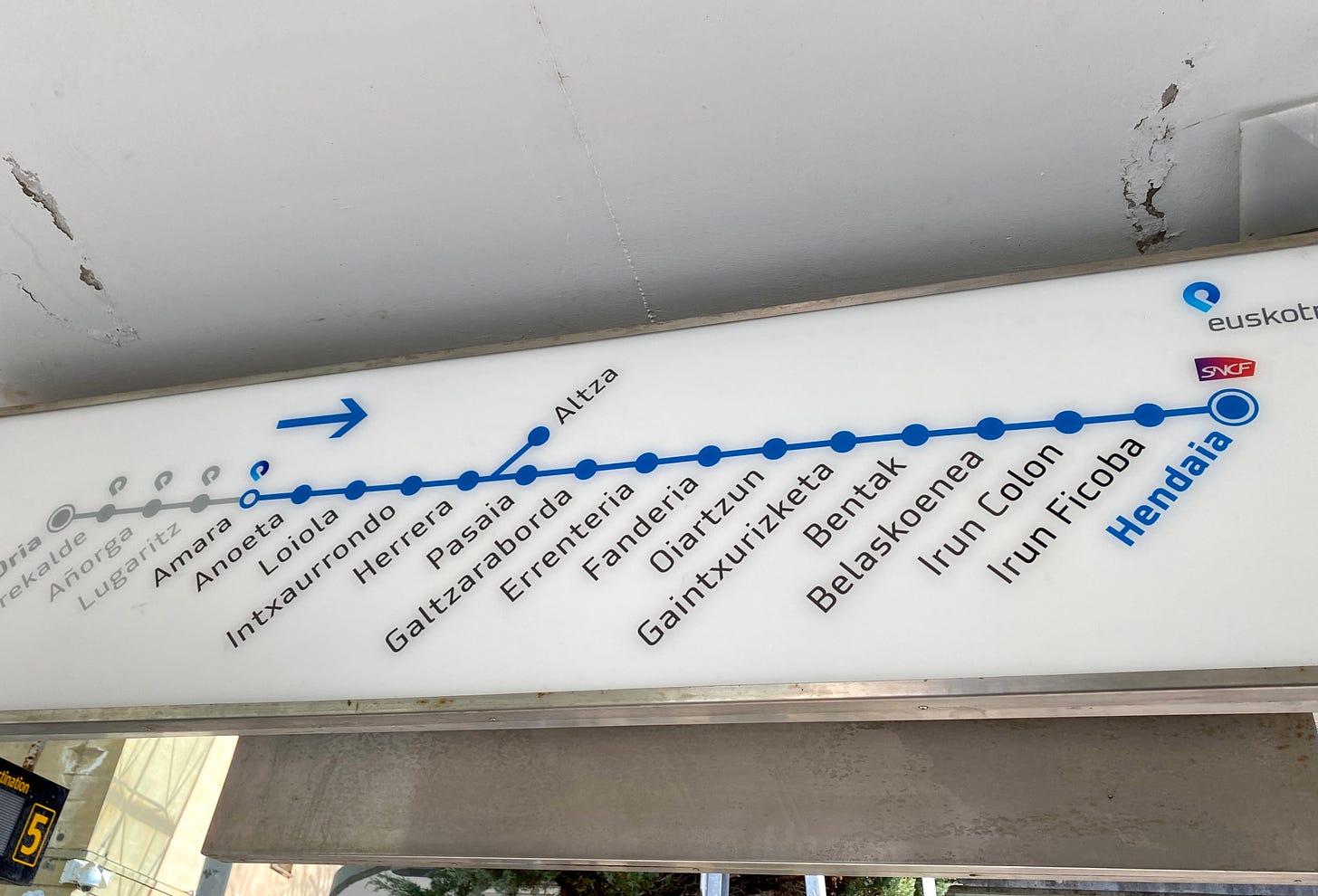

We had the most wonderful time in San Sebastián a few years ago. We splurged on the hotel Londres and had a room overlooking the bay. We liked it so much we didn’t go to Bilbao and stayed there 2 extra days. They upgraded us (I think because of our enthusiasm) to what was the grand opening of the top two floors. They were re-enacting a famous moment when Ava Gardener and an opera singer (whose name I forget) had a rendezvous at the hotel. The actress playing Gardener was staying next door and she was a lot of fun. She generously shared her cava with us. The rooms had lovely terraces with sun beds and her room had a big bathtub filled with bubbles. In the evening (to which we were not invited) bigwigs from the hotel’s parent company were invited up to her room where she was entertaining in her bathtub or on the terrace in a sexy bathrobe (which sounds like an oxymoron). For the next 2 days the staff referred to us as “the friends of Ava Gardner” pronounced “Ahva”. Everything we ate was delicious and we had fun at the pinxos places and at a place the hotel recommended right nearby. On day we drove to France for lunch and had a picnic of bread, cheese and freshly opened oysters in a parking lot. We dream of going back but are also afraid that some adventures just can’t be repeated. Thanks for reminding me of our wonderful time.
We just had three glorious weeks in Northern Spain and Southern France in September, and plan to return, so I love all of these suggestions. We stayed at a lovely parador in Hondarribia, just a few miles from San Sebastián. We happen to hit during the Festival of Guadalupe, which was fun to see. We had to drop off our rental in San Sebastián, and took the opportunity to spend the day. Thank you for the hotel suggestion as we plan on returning. One day was not enough. We had a private driver take us from Hondarribia to Saint Jean de Luz, where we spent a week. I highly recommend the Hotel de la Plage. We had the top corner room facing the ocean, and it was fabulous. It is in France, but because it is so close to the border it is the best of both worlds. The food was excellent. A great place for some R&R.